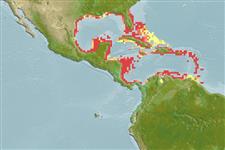Environment: milieu / climate zone / depth range / distribution range
Ökologie
seewasser; brackwasser riff-verbunden; tiefenbereich 0 - 11 m (Ref. 9710). Subtropical; 31°N - 9°N, 98°W - 59°W
Western Atlantic: northeastern Florida and northern Gulf of Mexico in the USA and the Bahamas to Campeche in Mexico and Lesser Antilles. Taxonomic status of populations from northern South America to Brazil uncertain.
Size / Gewicht / Alter
Maturity: Lm ? range ? - ? cm
Max length : 30.0 cm TL Männchen/unbestimmt; (Ref. 7251); common length : 20.0 cm TL Männchen/unbestimmt; (Ref. 3821)
Kurzbeschreibung
Morphologie | Morphometrie
Rückenflossenstacheln (insgesamt): 0; Rückenflossenweichstrahlen (insgesamt): 8; Afterflossenstacheln 0; Afterflossenweichstrahlen: 7. Upper side brown with large dark grey to black spots and light (pale blue or green in fresh specimens) irregular-shaped reticulations. Lower side with an irregular row of dusky to black rounded spots. The axil spot the most intense in the series. Sexually mature, ripe males sometimes covered with brilliant red or orange spots of about 1 mm in diameter (white in preserved specimen). No lappets on head or body (Ref 53033).
Inhabits bays, estuaries and protected coastal waters. Feeds primarily on shellfish, also on some finfish (Ref. 3821).
Life cycle and mating behavior
Geschlechtsreife | Fortpflanzung | Ablaichen | Eier | Fecundity | Larven
Robins, C.R. and G.C. Ray, 1986. A field guide to Atlantic coast fishes of North America. Houghton Mifflin Company, Boston, U.S.A. 354 p. (Ref. 7251)
IUCN Rote Liste Status (Ref. 130435)
Bedrohung für Menschen
Harmless
Nutzung durch Menschen
Fischereien: kleinfischerei
Mehr Information
Alter/GrößeWachstumLänge-GewichtLänge-LängeLängenhäufigkeitenMorphometrieMorphologieLarvenLarven Pop.Dyn.RekrutierungDichteBRUVS
ReferenzenAquakulturAquakultur ProfilZuchtlinienGenetikElectrophoresesVererbbarkeitKrankheitenVerarbeitungNutrientsMass conversion
PartnerBilderStamps, Coins Misc.LauteCiguateraGeschwindigkeitSchwimmstilKiemenoberflächeOtolithsGehirngrößeSehfähigkeit
Tools
Zusatzinformationen
Download XML
Internet Quellen
Estimates based on models
Preferred temperature (Ref.
123201): 24 - 28.1, mean 27.3 °C (based on 575 cells).
Phylogenetic diversity index (Ref.
82804): PD
50 = 0.5000 [Uniqueness, from 0.5 = low to 2.0 = high].
Bayesian length-weight: a=0.02291 (0.01327 - 0.03955), b=2.85 (2.70 - 3.00), in cm total length, based on LWR estimates for this species & Genus-body shape (Ref.
93245).
Trophic level (Ref.
69278): 3.5 ±0.37 se; based on food items.
Widerstandsfähigkeit (Ref.
120179): hoch, Verdopplung der Population dauert weniger als 15 Monate. (Preliminary K or Fecundity.).
Fishing Vulnerability (Ref.
59153): Low vulnerability (20 of 100).
Nutrients (Ref.
124155): Calcium = 31.7 [12.1, 119.3] mg/100g; Iron = 0.646 [0.304, 1.530] mg/100g; Protein = 19.4 [17.3, 21.6] %; Omega3 = 0.171 [0.083, 0.339] g/100g; Selenium = 11.4 [4.5, 28.0] μg/100g; VitaminA = 30.2 [7.5, 145.0] μg/100g; Zinc = 0.858 [0.518, 1.412] mg/100g (wet weight);
